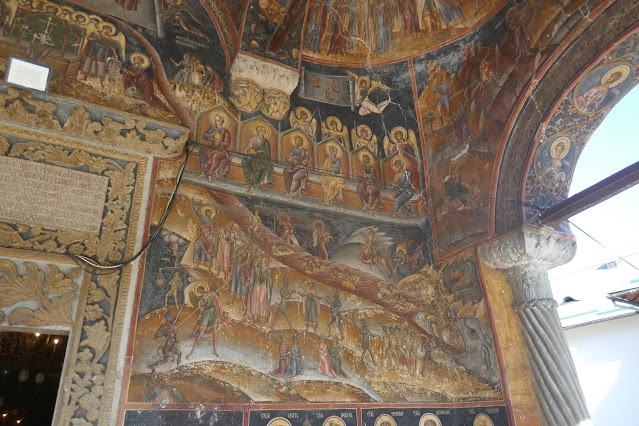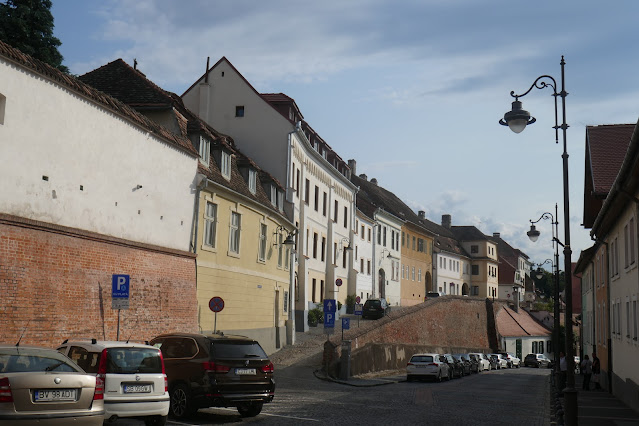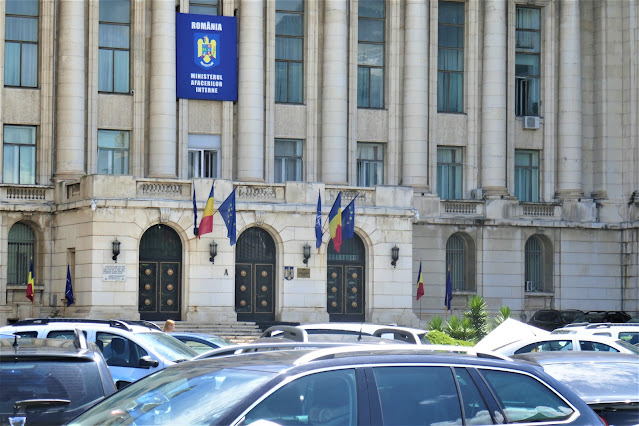A Painted Church and a 'Saxon' City
 |
| Romania |
 |
| We would drive northwest from Bucharest, pause at Cozia Monastery in Vâlcea County, then continue to Sibiu |
26-June-2023
Bucharest to Cozia Monastery
Cozia Monastey is 200km from Bucharest, and Google says the journey should take 3 hours. We left Bucharest around 1.15 and for a couple of hours we happily bowled along through rural Romania.
 |
| Speeding through rural Romania |
Then we reached the end of a tailback. The traffic was slow-moving and, as Vlad listened carefully to the traffic updates on the
radio, it became no-moving. We stopped for coffee and to make a plan.
An accident had closed the road several kilometres ahead, there was no
convenient alternative route, but if we backtracked a little, we could detour round it.
It was a lengthy detour, along roads which may have been minor, but were large enough and well maintained. We passed through open countryside,
small towns…
 |
| I am not sure what this place is called, but it has an impressive church |
…and rural villages.
 |
| Detouring through rural Romania |
Vlad was frequently driving in a convoy of cars following the same route for the same reason.
 |
| Vlad and his convoy |
Cozia Monastery
 |
| Vâlcea County |
The monastery was founded in 1388 beside the River Olt, a little north of the small town of Călimănești on the edge of what is today the
Cozia National Park. The name ‘Cozia,’ meaning 'walnut grove,' is derived from
the Cuman language of the Golden Horde, who reached this area around 1300.
Holy Trinity Church...
 |
| Holy Trinity, Cozia, with the monastery behind and around |
…. is partly surrounded by the monastery buildings which include the last remaining Byzantine cloister in Romania.
 |
| Part of the Monastery complex, Cozia |
 |
| Mircea the Elder |
The church, including the façade before the veranda was built in 1707, was decorated in Serbian Moravian style (stone rosettes,
horizontal rows of brick and stone, vertical frames) rather than Walachian. Mircea
cel Bătrân is assumed to have employed Serbian craftsmen.
 |
| Cozia Church rear view showing Serbian decorations and a brâncovenesc tower |
The church saw some rebuilding in 1517 and was remodelled in 1707, with a veranda, fountain and watchtower in brâncovenesc style. For the many (including me) who
have never heard of ‘brâncovenesc style’ (also known as Walachian Renaissance),
it blends mainstream European Renaissance styles with the Islamic architecture
of the dominant Ottoman Empire. It is named for Prince Constantin Brâncoveanu,
an enthusiastic builder of palaces and churches, who ruled Walachia 1688 - 1714.
 |
| Cozia Church Veranda |
Frescos
The glory of the church, though, is not in its
external architecture but in its frescos, the oldest dating back to the 1390s. The
service in progress inside the church, hampered our ability to wander round
taking photographs. There were also ‘no photographing’ signs which I would
happily ignore if not being watched. It does no harm, provided you do not use
flash, but modern cameras have no problem with the ambient light. As proof here
is a 5 second video (yes, it is that short) of the Romanian Orthodox service in
the church.
We could look as closely as we liked at the frescos in the veranda. Vlad interpreted them for us, reading from right to left, At the
time, I could not follow everything he said, and trying to make sense of it now
(few of my posts are written promptly after the events described) I am
bewildered.
There is no doubt the subject matter is The Judgement. The Holy Trinity – the church is dedicated to the Holy Trinity – sit over
the door and are clearly there to sort sheep from goats.
 |
| The Holy Trinity above the door into the church |
Traditionally the unfavoured go to God’s left, and here we can clearly see souls being marched off naked into hell. Centre stage, where clothes are removed there is a person of importance, a king maybe, desperately
trying to hang on to his dignity and his staff of office.
 |
| Veranda fresco to the right of the door into the church |
But how do souls reach the throne to be judged? Vlad suggested they come up from the right, but the general direction of
movement appears to be down. Looking more closely, it is tempting to interpret the
region just above the large downward path as being a trans-warp corridor in
which the righteous are swept up by an Archimedes screw of tetryon particles from
purgatory to the presence of the Almighty. (Can I also see the signature G
Roddenbury in the bottom right-hand corner?)
 |
| A closer look at the central section |
The left is even more confusing. A garden, perhaps with fruit trees. is being enjoyed by the Trinity and a few chosen souls at a respectful distance. Those men (I think they are all men) not destined for the fiery pit are supplied with haloes and allowed to look down onto the garden. Christians who still believe in hell are reasonably clear on the torments involved, but no mainstream church has ever come up with a believable description of the delights of heaven, possibly because every activity humans enjoy has been denounced as sinful by one group or another over the centuries. This, though, is the least inspiring vision of heaven I could imagine, short of clouds and harps.
 |
| Veranda fresco left of the door |
Cozia to Sibiu
Leaving Cozia around 6, we continued north, the road joining the River Olt just above a dam. The Olt is the longest river entirely within
Romania, flowing 600km south from the Hășmaș Mountains to the Danube on the
Romanian/Bulgarian border.
 |
| The River Olt |
For a time, we enjoyed the countryside and farming techniques that have longed died out in western Europe
 |
| Older farming techniques |
Sibiu is 80km from Cozia, but Google suggests the journey takes an hour and forty minutes. Clearly, they knew about the traffic problems. …
 |
| Slow progress on the road to Sibiu |
…but severly underestimated the length of the delay. We reached Sibiu around 9 o’clock.
Sibiu
Some History
.jpg) |
| Sibiu (county) |
 |
| Sibiu City |
In the 12th and 13th centuries the Hungarian kings invited Germanic settlers to help defend their southeastern border against the Cumans
and later the Ottomans. These people became known as the Transylvanian Saxons,
though they were not all from Saxony. By the middle of the 19th century,
Transylvania’s ethnic mix was 60% Romanian, 25% Hungarian and 10% Transylvanian
Saxon.
The Hungarians were a land owning elite, the Germans, professionals and artisans, formed a largely urban middle and upper middle class while the Romanians toiled in the fields. This view is supported by the 1850 census which found the city of Sibiu ( then capital of the Principality of Transylvania) was home to 2,089 Romanians, 977 Hungarians and 8,790 Germans. Sibiu was effectively a small German city and was generally known as Hermannstadt.
Sibiu Today
The outskirts of Sibiu are unremarkable, but pleasant enough, mercifully lacking the worst of the dwelling blocks thrown up by all
communist governments.
The centre is different, a delightful old German city that is somehow obviously not in Germany. We checked in to our hotel which stood, almost unsigned
on a lane rising beside the road.
 |
| Our hotel is on the little lane rising to the left |
We took our luggage up to our room, I unlocked the door and stepped forward without looking. An unexpected sensation of falling
was my first indication that the room was four steps below corridor level.
For a very long second or so I ran flat out, as my feet attempted to catch up
with my toppling torso. To my surprise and relief, I made it by the fourth step
and continued, largely in control, to a relatively gentle collision with the
wall opposite. Well that woke me up, after an hour sitting in a traffic jam.
A few minutes later, we were walking up to the centre to find some dinner. Sibiu was European City of Culture in 2007, and has rather
developed a taste for it…
 |
| 2007 European City of Culture drain cover |
…and we had arrived during the annual arts festival. The big central square was surrounded by restaurants and at 9.30 empty tables
were rare. We toured round until we spotted one and sat quickly, heedless of the menu. It had been a long day and this was not the time for gastronomy, Lynne
had chicken and chips and I had chicken pie of sorts. Large restorative beers
seemed important..
 |
| Chicken and Chips, Sibiu |
Afterwards we walked round the square, enjoying the atmosphere and viewing an installation involving birdseed that was so far incomplete.
A mirror wall stood across the end of the square ...
 |
| The mirror across the main square, Sibiu |
...so we photographed ourselves.
27-Jun-2023
Sibiu, The City with Eyes
The following morning we set out to visit Hunedoara and Alba Iulia, and that is the subject of the next post.
We did not have time to
look around yesterday, but as we walked to Vlad’s car, he mentioned that Sibiu is
known as The City with Eyes. Their purpose is to ventilated the attic,
but some see them as narrowed and suspicious, and they have featured in an anticorruption
drive: ‘Sibiu is watching you’ To me they look relaxed and sleepy.
 |
| Sibiu, The City with Eyes |
On our return Vlad conducted a walking tour. Sibiu had a population of 12,000 on 1850, today it
has ten times as many. The city has spread
across the plain but 150 years ago, the much smaller and largely German
speaking population lived either in the Lower Town, if they were artisans and
traders, or the Upper Town if they were wealthy merchants. Longer ago, in
wilder times, the upper town had been a fortified citadel
Yesterday we had walked up the gently graded road, this time we used the stairs. From the top we had a fine view down into the Lower Town.
 |
| Sibiu, Lower Town |
At the top was the Casa Cafelor, the House of Journeymen. Built in the 16th century it was a Guild House for the Guild of Hatters.
 |
| Casa Calefor, Sibiu |
From there we crossed the
Bridge of Lies to the Upper Town’s Small Square (Piața Mică).
 |
| On the Bridge of Lies |
Many legends surround the name, mostly involving those who tell untruths - whether merchants or lovers –
being lobbed over the parapet (see Wikipedia: Bridge of Lies).
None of them are true, it is the bridge that lies, but only across the gap below.
There is a nice
collection of sleepy eyes on the left of the picture, while the tower on the
right is Sibiu’s Council Tower situated between the Small Square and Great
Square (Piața Mare). Originally built in the 12th century but often reconstructed,
it has had many uses but is today an exhibition space.
Nearby the Casa Luxembourg Hotel has an elaborate 17th century façade.
 |
| Casa Luxembourg |
The Holy Trinity Catholic
Church is tucked into a corner of Great Square. It is relatively modest, but I
blame the Art’s Festival boarding for my poor photograph.
 |
| Roman Catholic Church Sibiu |
Inside, the church maintains an ornate dinginess, which I imagine may have been learnt during the Ceaușescu years.
 |
| Roman Catholic Church, Sibiu |
I did like the pulpit, though.
 |
| Pulpit, Sibiu catholic church |
Dinner in the Tower
Our walking tour drew to
close at this point, but less than an hour later we were in La Turn (The Tower) Restaurant, recommended by Vlad, which is not in a tower, but does have
entrances on both Small and Great Squares.
 |
| La Turn, Sibiu |
We started with ţuică, a
plum brandy which, like its cousin slivovitz, is drunk as an aperitif.
Lynne chose a Greek salad, while I went for the Peasant Platter - I know my place.
 |
| Peasant Platter |
According to the menu’s translation peasants eat pork tenderloin, polenta, egg-eye, bellows and pickled cucumber. Polenta is a
Romanian staple, egg-eye was obviously fried egg, and for pickled cucumber read
gherkins, but bellows? ‘Burduf’ the word on the Romanian menu literally means bellows,
as in equipment for blowing air not being shouty. It is also, apparently, a
cheese made in Brasov from fresh sheep or buffalo milk cheese which is salted
and kneaded. It was a good, hearty platter and I enjoyed it.
Romania: An Introduction
Part 1 Bucharest
Part 2 Cozia Monastery and Sibiu
Part 3 Hunedoara and Alba Iulia
Part 4 Biertan and Sighișoara
Part 5 Rupea and Brașov
Part 6 Bears and Dracula's Castle(?)
Part 7 From Brașov back to Bucharest












































